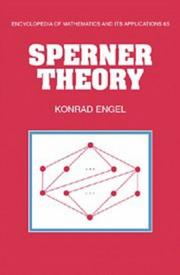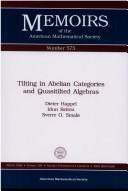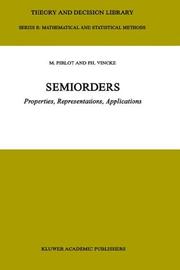| Listing 1 - 10 of 11 | << page >> |
Sort by
|

ISBN: 1139886509 0511959648 1107103037 110708864X 0511574711 1107094836 1107091578 9781107088641 0521452066 9780521452069 Year: 1997 Publisher: Cambridge ; New York : Cambridge University Press,
Abstract | Keywords | Export | Availability | Bookmark
 Loading...
Loading...Choose an application
- Reference Manager
- EndNote
- RefWorks (Direct export to RefWorks)
The starting point of this book is Sperner's theorem, which answers the question: What is the maximum possible size of a family of pairwise (with respect to inclusion) subsets of a finite set? This theorem stimulated the development of a fast growing theory dealing with external problems on finite sets and, more generally, on finite partially ordered sets. This book presents Sperner theory from a unified point of view, bringing combinatorial techniques together with methods from programming, linear algebra, Lie-algebra representations and eigenvalue methods, probability theory, and enumerative combinatorics. Researchers and graduate students in discrete mathematics, optimisation, algebra, probability theory, number theory, and geometry will find many powerful new methods arising from Sperner theory.
Partially ordered sets. --- Sperner theory. --- Sperner's theorem --- Theorem, Sperner's --- Combinatorial analysis --- Posets --- Sets, Partially ordered --- Ordered sets --- Sperner theory --- Partially ordered sets

ISSN: 00659266 ISBN: 082180622X Year: 1997 Publisher: Providence, R.I.
Abstract | Keywords | Export | Availability | Bookmark
 Loading...
Loading...Choose an application
- Reference Manager
- EndNote
- RefWorks (Direct export to RefWorks)
Mathematical analysis --- Partially ordered sets. --- Ensembles partiellement ordonnés. --- Combinatorial set theory. --- Ensembles, Théorie combinatoire des. --- Combinatorial set theory --- Partially ordered sets --- Posets --- Sets, Partially ordered --- Ordered sets --- Set theory, Combinatorial --- Combinatorial analysis --- Set theory
Book
ISBN: 9780821872949 Year: 2013 Volume: v 223 , number 1050 Publisher: Providence, R.I. American Mathematical Society
Abstract | Keywords | Export | Availability | Bookmark
 Loading...
Loading...Choose an application
- Reference Manager
- EndNote
- RefWorks (Direct export to RefWorks)
Ordered algebraic structures --- Partially ordered sets. --- Schur functions --- Ensembles partiellement ordonnés --- Fonctions de Schur --- Schur functions. --- 51 <082.1> --- Mathematics--Series --- Ensembles partiellement ordonnés --- Partially ordered sets --- S-functions --- Schur's functions --- Holomorphic functions --- Posets --- Sets, Partially ordered --- Ordered sets

ISSN: 00659266 ISBN: 0821804448 Year: 1996 Publisher: Providence, R.I. American Mathematical Society
Abstract | Keywords | Export | Availability | Bookmark
 Loading...
Loading...Choose an application
- Reference Manager
- EndNote
- RefWorks (Direct export to RefWorks)
Ordered algebraic structures --- Artin rings. --- Representations of rings (Algebra) --- Partially ordered sets --- Representations of algebras --- Anneaux artiniens. --- Ensembles partiellement ordonnés. --- Représentations d'algèbres. --- Artin rings --- Rings (Algebra) --- Algebra --- Posets --- Sets, Partially ordered --- Ordered sets --- Artinian rings --- Rings, Artin --- Rings, Artinian --- Associative rings --- Commutative rings
Book
ISBN: 9780821869109 Year: 2012 Volume: no. 1024 Publisher: Providence, R.I. American Mathematical Society
Abstract | Keywords | Export | Availability | Bookmark
 Loading...
Loading...Choose an application
- Reference Manager
- EndNote
- RefWorks (Direct export to RefWorks)
Artin algebras --- Partially ordered sets. --- Commutative algebra. --- Algèbres artiniennes --- Ensembles partiellement ordonnés --- Algèbre commutative --- Artin algebras. --- Algèbres artiniennes --- Ensembles partiellement ordonnés --- Algèbre commutative --- Algebra --- Commutative algebra --- Partially ordered sets --- 51 <082.1> --- Posets --- Sets, Partially ordered --- Ordered sets --- Algebras, Artin --- Artin rings --- Modules (Algebra) --- Mathematics--Series

ISBN: 0792346173 9048148693 940158883X 9780792346173 Year: 1997 Volume: v. 36 Publisher: Dordrecht : Kluwer academic,
Abstract | Keywords | Export | Availability | Bookmark
 Loading...
Loading...Choose an application
- Reference Manager
- EndNote
- RefWorks (Direct export to RefWorks)
Semiorder is probably one of the most frequently ordered structures in science. It naturally appears in fields like psychometrics, economics, decision sciences, linguistics and archaeology. It explicitly takes into account the inevitable imprecisions of scientific instruments by allowing the replacement of precise numbers by intervals. The purpose of this book is to dissect this structure and to study its fundamental properties. The main subjects treated are the numerical representations of semiorders, the generalizations of the concept to valued relations, the aggregation of semiorders and their basic role in a general theoretical framework for multicriteria decision-aid methods. Audience: This volume is intended for students and researchers in the fields of decision analysis, management science, operations research, discrete mathematics, classification, social choice theory, and order theory, as well as for practitioners in the design of decision tools.
Besluitvorming--Problemen --- Decision problems --- Décision [Prise de ]--Problèmes --- Décision statistique --- Ensembles partiellement ordonnés --- Gedeeltelijke geordende gehelen --- Partially ordered sets --- Posets --- Sets [Partially ordered ] --- Statistical decision --- Decision making --- Prise de décision --- Mathematical models --- Modèles mathématiques --- Game theory --- Operations research --- Statistics --- Management science --- Sets, Partially ordered --- Ordered sets --- Partially ordered sets. --- Statistical decision. --- Prise de décision --- Modèles mathématiques --- Operations research. --- Decision making. --- Algebra. --- Ordered algebraic structures. --- Mathematical logic. --- Operations Research/Decision Theory. --- Order, Lattices, Ordered Algebraic Structures. --- Mathematical Logic and Foundations. --- Algebra of logic --- Logic, Universal --- Mathematical logic --- Symbolic and mathematical logic --- Symbolic logic --- Mathematics --- Algebra, Abstract --- Metamathematics --- Set theory --- Syllogism --- Algebraic structures, Ordered --- Structures, Ordered algebraic --- Algebra --- Mathematical analysis --- Deciding --- Decision (Psychology) --- Decision analysis --- Decision processes --- Making decisions --- Management --- Management decisions --- Choice (Psychology) --- Problem solving --- Operational analysis --- Operational research --- Industrial engineering --- Research --- System theory
Book
ISBN: 8680593206 9788680593203 Year: 1996 Publisher: Beograd: Matematički institut SANU,
Abstract | Keywords | Export | Availability | Bookmark
 Loading...
Loading...Choose an application
- Reference Manager
- EndNote
- RefWorks (Direct export to RefWorks)
Topology --- Set theory --- Computer science --- Partially ordered sets --- Axiomatic set theory --- Number theory --- Mathematics --- -Number theory --- Analysis situs --- Position analysis --- Rubber-sheet geometry --- Geometry --- Polyhedra --- Algebras, Linear --- Aggregates --- Classes (Mathematics) --- Ensembles (Mathematics) --- Mathematical sets --- Sets (Mathematics) --- Theory of sets --- Logic, Symbolic and mathematical --- Posets --- Sets, Partially ordered --- Ordered sets --- Number study --- Numbers, Theory of --- Algebra --- Informatics --- Science --- Axioms --- Number Theory --- Computer mathematics --- Discrete mathematics --- Electronic data processing --- Computer science - Mathematics
Book
ISBN: 3319938215 3319938207 Year: 2018 Publisher: Cham : Springer International Publishing : Imprint: Springer,
Abstract | Keywords | Export | Availability | Bookmark
 Loading...
Loading...Choose an application
- Reference Manager
- EndNote
- RefWorks (Direct export to RefWorks)
This book offers an organized and systematic approach to poset metrics and codes. Poset metrics, or metrics on a vector field determined by a partial order over a finite set, was first introduced in the mid-1990s by the mathematicians Richard A. Brualdi, Janine S. Graves and K. Mark Lawrence, and to date the relevant knowledge on this subject was spread over more than two hundred research papers. Poset metrics generalizes both the standard Hamming metric – the most important metric used in the context of coding theory – and the Niederreiter-Rosenbloom-Tsfasman metric, which is an ultrametric. Conceived to be as self-contained as possible, the book starts from basic concepts of coding theory and advances towards poset proprieties and generalizations. Each chapter includes a survey of the topic presented and a list of exercises, drawn in part from recently proven propositions. This work will appeal to researchers and graduate students alike, particularly those in the fields of Mathematics, Electrical Engineering and Computer Sciences, with an interest in discrete geometry and coding theory.
Partially ordered sets. --- Posets --- Sets, Partially ordered --- Ordered sets --- Algebra. --- Coding theory. --- Discrete groups. --- Number theory. --- Order, Lattices, Ordered Algebraic Structures. --- Coding and Information Theory. --- Convex and Discrete Geometry. --- Number Theory. --- Number study --- Numbers, Theory of --- Algebra --- Groups, Discrete --- Infinite groups --- Data compression (Telecommunication) --- Digital electronics --- Information theory --- Machine theory --- Signal theory (Telecommunication) --- Computer programming --- Mathematics --- Mathematical analysis --- Discrete mathematics --- Ordered algebraic structures. --- Information theory. --- Convex geometry . --- Discrete geometry. --- Geometry --- Combinatorial geometry --- Communication theory --- Communication --- Cybernetics --- Algebraic structures, Ordered --- Structures, Ordered algebraic
Book
ISBN: 3030596834 3030596826 Year: 2021 Publisher: Cham, Switzerland : Springer,
Abstract | Keywords | Export | Availability | Bookmark
 Loading...
Loading...Choose an application
- Reference Manager
- EndNote
- RefWorks (Direct export to RefWorks)
Indicators are more and more applied to describe and analyze complex systems. Typical examples: Innovation potential of nations, child-well being, Environmental health, poverty, chemical pollution, corruption of nations. The task is: How can a system of indicators be defined in order to fulfill the above expectations. One possibility is the application of the mathematical theory of partial order, especially when the indicator system shall be used for ranking purposes.
Environmental sciences. --- Statistics . --- Environmental monitoring. --- Technology. --- Environmental management. --- Math. Appl. in Environmental Science. --- Applied Statistics. --- Monitoring/Environmental Analysis. --- Applied Science, multidisciplinary. --- Environmental Management. --- Environmental stewardship --- Stewardship, Environmental --- Environmental sciences --- Management --- Applied science --- Arts, Useful --- Science, Applied --- Useful arts --- Science --- Industrial arts --- Material culture --- Biomonitoring (Ecology) --- Ecological monitoring --- Environmental quality --- Monitoring, Environmental --- Applied ecology --- Environmental engineering --- Pollution --- Statistical analysis --- Statistical data --- Statistical methods --- Statistical science --- Mathematics --- Econometrics --- Environmental science --- Measurement --- Monitoring --- Partially ordered sets. --- Posets --- Sets, Partially ordered --- Ordered sets
Book
ISBN: 1281861634 9786611861636 1848002017 9781848002005 1848002009 9781848002012 1849967512 Year: 2008 Publisher: London : Springer,
Abstract | Keywords | Export | Availability | Bookmark
 Loading...
Loading...Choose an application
- Reference Manager
- EndNote
- RefWorks (Direct export to RefWorks)
The maturing of the field of data mining has brought about an increased level of mathematical sophistication. Such disciplines like topology, combinatorics, partially ordered sets and their associated algebraic structures (lattices and Boolean algebras), and metric spaces are increasingly applied in data mining research. This book presents these mathematical foundations of data mining integrated with applications to provide the reader with a comprehensive reference. Mathematics is presented in a thorough and rigorous manner offering a detailed explanation of each topic, with applications to data mining such as frequent item sets, clustering, decision trees also being discussed. More than 400 exercises are included and they form an integral part of the material. Some of the exercises are in reality supplemental material and their solutions are included. The reader is assumed to have a knowledge of elementary analysis. Features and topics: • Study of functions and relations • Applications are provided throughout • Presents graphs and hypergraphs • Covers partially ordered sets, lattices and Boolean algebras • Finite partially ordered sets • Focuses on metric spaces • Includes combinatorics • Discusses the theory of the Vapnik-Chervonenkis dimension of collections of sets This wide-ranging, thoroughly detailed volume is self-contained and intended for researchers and graduate students, and will prove an invaluable reference tool.
Data mining. --- Partially ordered sets. --- Metric spaces. --- Set theory. --- Computer science. --- Computer science --- Computer mathematics. --- Computer Science. --- Data Mining and Knowledge Discovery. --- Mathematics of Computing. --- Discrete Mathematics in Computer Science. --- Computational Mathematics and Numerical Analysis. --- Informatics --- Science --- Algorithmic knowledge discovery --- Factual data analysis --- KDD (Information retrieval) --- Knowledge discovery in data --- Knowledge discovery in databases --- Mining, Data --- Database searching --- Computer mathematics --- Discrete mathematics --- Electronic data processing --- Mathematics. --- Mathematics --- Aggregates --- Classes (Mathematics) --- Ensembles (Mathematics) --- Mathematical sets --- Sets (Mathematics) --- Theory of sets --- Logic, Symbolic and mathematical --- Posets --- Sets, Partially ordered --- Ordered sets --- Spaces, Metric --- Generalized spaces --- Set theory --- Topology --- Computational complexity. --- Complexity, Computational --- Machine theory --- Computer science—Mathematics.
| Listing 1 - 10 of 11 | << page >> |
Sort by
|

 Search
Search Feedback
Feedback About UniCat
About UniCat  Help
Help News
News